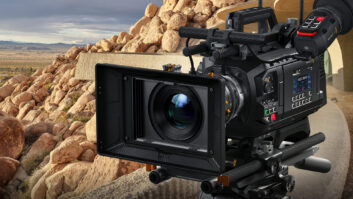
Asset management has come a long way since the days of analogue infrastructures, and the demands and expectations placed on current and next generation MAM systems are ever changing. To examine the latest thinking on MAM, we spoke to Niall Duffy, head of IT and workflow solutions, Professional Solutions Europe, Sony; Craig Dwyer, senior director, global presales, Avid; Phil Eade, director of media logistics, Ooyala; and Paul Wilkins, director of solutions and marketing, TMD
MAM systems have had to adapt to the changing and growing demands placed upon them by broadcasters and content providers. Are traditional systems equipped to deal with these demands?
Duffy: The key lesson learned from the past five years is that a MAM should not try to do everything. We are now seeing a shift to more focused use of MAM technology, either where it fits into a particular niche (such as news, archive, content services, playout), or where it provides a core set of functionality. Key to this development is the model of micro services and strong APIs that can support broader integration. The more a company shrinks back the role of the MAM, the easier it will be for them to meet the future needs. At heart, a MAM is a catalogue, asset manager and access manager. Systems and solutions that can choreograph and manage multiple MAM systems to support new business workflows will be the future, rather than bigger and better MAMs.
Dwyer: In today’s media environment, enterprises are under intense pressure to improve content monetisation and maximise operational efficiency. They’re expected to do more – to create more content for more platforms and deliver it to more people – so they have to find new ways to secure revenues, differentiate services to earn audience loyalty, and deliver all these services at a lower cost.
One of the key routes to achieving this goal is through MAM. But, these systems needs to be future-proof to meet whatever new challenges media organisations will face in the future. Therefore, flexibility, extendibility and the scalability to address specific business or operational needs are paramount requirements of a MAM system, especially if total media enterprise transformation is the ultimate goal.
Eade: No. Traditional systems were built with traditional, linear broadcast distribution in mind. With the growing popularity of digital and OTT channels, broadcasters now need systems that can handle the demands of both linear and digital production and distribution. They need solutions that allow them to dynamically and cost-effectively expand and evolve their business; whether that’s adding new content or partners, expanding to international markets or creating content specifically for digital channels. And, they need systems that can integrate and automate processes across the entire video supply chain, not just part of it, but through broadcasts and OTT delivery.
Wilkins: Adaptability has always been the marker of successful asset management systems because no two broadcasters or media enterprises have the same requirements. Today, we achieve that adaptability through software-defined workflows, using the metadata we acquire, extract and create to automatically drive our workflows.
What are the greatest considerations for broadcasters when assessing their MAM options?
Duffy: The starting point ought to be an overall view of the content supply chain and identifying where MAM technology is required, and identifying those requirements and potential benefits. They then should consider whether those requirements benefits can be achieved through better management of content, or where productivity can be improved through automation or streamlining of content and metadata driven workflows. If you already have a MAM, you may not need another, you might just need a better way of managing workflows.
Dwyer: MAM is widely seen as a fundamental component of any media enterprise, and users are confident about its ability to deliver a return on investment. It’s essential in enabling media enterprises to compete effectively – by reducing media lifecycle costs, unlocking new revenues, and boosting collaboration and productivity by making media assets accessible throughout the organisation.
MAM should today be seen as the workflow engine, driving automated processes as much as possible, and thereby reducing costs as well as serving more markets and outlets. Across the globe, clients are thinking about the end-to-end their media life-cycle and starting to plan more holistically across the operation.
Eade: We consult many broadcasters on how to approach technology investments. We start by asking ‘what is the goal of your media operations?’ Most say the goal is to increase revenues. Therefore, any technology investment should be evaluated accordingly: will it increase the rate their operation generates money? Can they generate more sellable content? Will it decrease production spend or operational expense? Traditional MAMs typically fall short in at least one of those categories. That’s why the need has evolved beyond MAM solutions to include workflow automation and collaboration tools, seamless metadata management, and rich analytics for smarter business decisions.
Wilkins: If you are thinking about how to specify asset management, you are starting from the wrong place. The modern, software-defined architecture is all about creating, adapting and automatically initiating complex workflows, drawing on and enriching the metadata. Because everything depends upon good metadata, what we used to think of as asset management the necessary evil is now the orchestration layer for the whole architecture, and you should be designing on the basis of the outcomes you want to achieve.
What are the absolute must-haves of any modern MAM system?
Duffy: The next generation of MAM systems (4th gen) need to support hybrid cloud infrastructures – a modern MAM should not be either in a cloud or premise – it should have the ability to be both, to support modern content workflows. It needs to be able to support metadata on a cloud platform and with audio visual content stored locally; it must have open and robust APIs and it must be both a platform – that is, something that is capable of continuous adaption was well as agile and scalable.
Dwyer: The MAM system is seen as a key strategic investment. It provides wide-scale access to content, and it can take an active role in identifying and promoting content that has a revenue opportunity attached to it. And as the repository of metadata, it’s seen as the heart of workflow processes and automation.
The real benefits of a modern MAM system come in the ability to store, update and maintain comprehensive metadata, and to use this to drive automated workflows. This can only happen in an organisation that has reviewed all its processes and considered how best they can be accomplished in the future. If you just carry on as you are today but with the MAM system alongside you, it’s unlikely that you’ll see advances in audience engagement, operational efficiency and cost savings.
Eade: Broadcasters should prioritise these capabilities:
– Integration: the ability to connect to legacy systems, new technologies and the workflows associated with those systems
– Configurability: the ability to easily configure workflows to match your needs, including those that have been assembled over time, and to update instantly once changes are made
– Adaptability: the ability to expand and evolve broadcast operations or create new services required to grow a business, without disrupting existing operations
– Data-first focus: the ability to model asset relationships and related business data, as well as manage metadata to ensure visibility, control, reporting and continuity across entire operation
Wilkins: Three things: a completely configurable, infinitely scalable metadata schema; a powerful workflow engine that can provide the orchestration for the whole software-defined, service-oriented architecture; and an intuitive user interface which allows you to create precisely the workflows you need, quickly and securely – the technology is useless if you cannot make it do what you need it to do, in house and in time.
Where can broadcasters derive the greatest return on investment from their asset management system?
Duffy: Mostly they will not derive any significant return: now we are all file-based, a MAM of some form is essential once you hit any volume of content. We need to think of MAMs as a means of structuring and controlling ‘digital buckets’. A ROI will either come from cost savings or enabling new revenue streams, and those will be delivered through supply chain optimisation, metadata-driven workflow engines, not MAMs. The ROI for these workflow systems will be generated by extended use of the existing content, data and platforms rather than replacement and migration.
Dwyer: A broadcast MAM system is more than just a single asset management solution. It provides the broadcaster with complete visibility of their media content, wherever it’s located, and it connects every contributor in your business wherever they are.
MAM is proven to solve key business and operational challenges that many media organisations face today. However, to achieve a successful outcome, MAM should be designed and implemented in close collaboration with the customer. Understanding their needs at every stage, from design through to implementation, and beyond, is imperative.
A MAM system provides analytics and workflow orchestration, simplifies day-to-day manual production tasks, and connects media production solutions with external business systems, providing every contributor in the business with the right tools for their role and access to all the content they need. It’s fair to say that in today’s world, the word MAM no longer fully describes all the benefits that a broadcast MAM solution delivers.
Eade: Traditional MAMs will have difficulty proving ROI. But asset management combined with workflow automation has proven to deliver significant ROI. Ooyala Flex recently helped a global post-production company reduce their project delivery time by 85 per cent, enabling them to take on more projects (increase revenue) and invest in talent. We call that the ‘automation premium’ – the return customers get by connecting their value chain, automating processes and increasing visibility. There’s also an ‘optimisation premium’ that can be achieved by using data to identify and remove bottlenecks, or balancing flow with demand and scaling services up and down as needed.
Wilkins: Every broadcaster and media company is different, so each will find different key performance indicators. Some will want to catalogue and archive programmes, clips and related media for future sales. Some will need fast access to any part of a growing archive. Some will want to handle raw content as part of the production process. You have to calculate the benefit/cost ratio of each implementation based on what that user needs.
Finally, considering the evolving functions of these systems, will we soon render the term MAM redundant?
Duffy: No, I don’t think so. It was painful enough settling on MAM and now that everyone knows what they think is a MAM, there is no point in changing. But there is also no need, as the evolving functions will be served by other systems and there we will need a new term, be that Media Operations Management or Supply Chain Management.
Dwyer: Originally, asset management was seen as a low-level function, a means of keeping track of content, but MAM technology has had to mature very quickly to cater for today’s anytime, anywhere audience.
The next generation of MAM systems will need to address the critical pain points that media organisations face. One is the digitisation of media and the world that we live in. There’s increasing consumer influence over content, how, where and why they watch content, and whether or not they’re willing to pay for it, and there’s continual pressure to improve operational efficiency. Broadcasters have to make difficult decisions about how much they want to invest in original programming and how much they want to spend on rights for overseas or domestic content
The next phase of MAM development requires a number of cross-industry challenges to be addressed. The first is interoperability to enable a wide range of content processing, packaging, manipulation, and storage systems to be integrated into a unified environment. The second is enabling systems to easily capture, track and share metadata, making it far easier to leverage content and improve reuse.
Wilkins: We now tend to talk about asset and workflow management, because the two are so intimately entwined. The truth is that the new generation of asset management systems should be invisible, being the platform on which automatic and manual workflows run. It should provide the orchestration layer for the whole enterprise, communicating up to business systems and down to broadcast-specific technology and software applications. It’s not easy to summarise that in a snappy phrase, so for now we talk about asset and workflow management.






